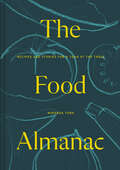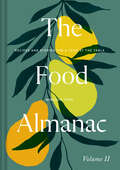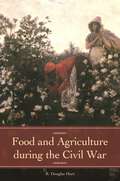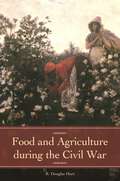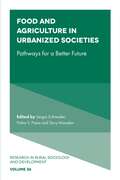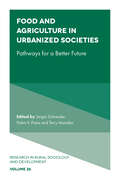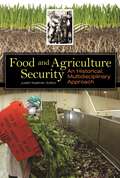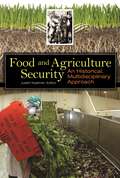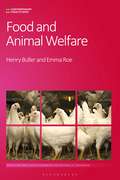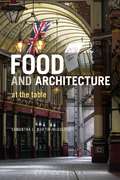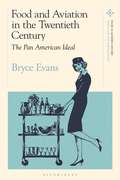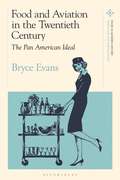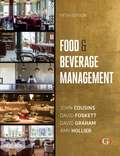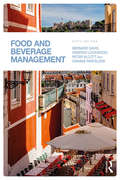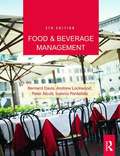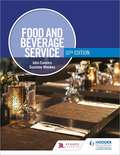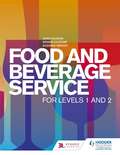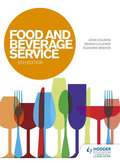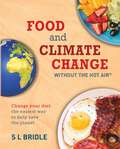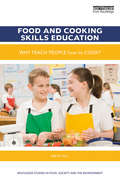- Table View
- List View
The Food Almanac: Recipes And Stories For A Year At The Table
by Miranda YorkSHORTLISTED FOR THE FORTNUM & MASON FOOD AND DRINK AWARDS 2021 The Food Almanac is a seasonal collection of recipes and stories celebrating the joy of food – a dazzling, diverse mix of memoir, history, short stories and poems alongside recipes, cooking tips, menus and reading lists.
The Food Almanac: Volume Two
by Miranda YorkThe Food Almanac II is an annual, seasonal collection of recipes and stories celebrating the joy of food – a dazzling, diverse mix of memoir, history, short stories and poems alongside recipes, cooking tips, menus and reading lists.
Food and Agriculture during the Civil War (Reflections on the Civil War Era)
by R. Douglas HurtThis book provides a perspective into the past that few students and historians of the Civil War have considered: agriculture during the Civil War as a key element of power.The Civil War revolutionized the agricultural labor system in the South, and it had dramatic effects on farm labor in the North relating to technology. Agriculture also was an element of power for both sides during the Civil War—one that is often overlooked in traditional studies of the conflict. R. Douglas Hurt argues that Southerners viewed the agricultural productivity of their region as an element of power that would enable them to win the war, while Northern farmers considered their productivity not only an economic benefit to the Union and enhancement of their personal fortunes but also an advantage that would help bring the South back into the Union.This study examines the effects of the Civil War on agriculture for both the Union and the Confederacy from 1860 to 1865, emphasizing how agriculture directly related to the war effort in each region—for example, the efforts made to produce more food for military and civilian populations; attempts to limit cotton production; cotton as a diplomatic tool; the work of women in the fields; slavery as a key agricultural resource; livestock production; experiments to produce cotton, tobacco, and sugar in the North; and the adoption of new implements.
Food and Agriculture during the Civil War (Reflections on the Civil War Era)
by R. Douglas HurtThis book provides a perspective into the past that few students and historians of the Civil War have considered: agriculture during the Civil War as a key element of power.The Civil War revolutionized the agricultural labor system in the South, and it had dramatic effects on farm labor in the North relating to technology. Agriculture also was an element of power for both sides during the Civil War—one that is often overlooked in traditional studies of the conflict. R. Douglas Hurt argues that Southerners viewed the agricultural productivity of their region as an element of power that would enable them to win the war, while Northern farmers considered their productivity not only an economic benefit to the Union and enhancement of their personal fortunes but also an advantage that would help bring the South back into the Union.This study examines the effects of the Civil War on agriculture for both the Union and the Confederacy from 1860 to 1865, emphasizing how agriculture directly related to the war effort in each region—for example, the efforts made to produce more food for military and civilian populations; attempts to limit cotton production; cotton as a diplomatic tool; the work of women in the fields; slavery as a key agricultural resource; livestock production; experiments to produce cotton, tobacco, and sugar in the North; and the adoption of new implements.
Food and Agriculture in Urbanized Societies: Pathways for a Better Future (Research in Rural Sociology and Development #26)
by Sergio Schneider Potira V. Preiss Terry MarsdenFor the first time in human history, more people inhabit urban than rural areas. Investigating the experience of hunger and malnutrition in urban spaces, Food and Agriculture in Urbanized Societies confronts the persistence of social inequalities, constant waves of economic crises and accelerating climate shifts, asking, how and to what extent food systems will recover and rebuild after the unprecedented eruption of a pandemic? An in-depth diagnosis of the state of the art of the current and dominant agri-food system, the broad and diverse collective intelligence in this edited collection proposes alternatives for change and redesign, bringing together a set of pioneering ideas and solutions to old and new problems. From environmental regeneration and the quality of food to the nutritional, political and economic perspective, the chapters culminate with the focus on developing a more integrative and systematic approach towards urban and rural areas. Inspiring innovative and sustainable practices, governance perspectives and informing public policies, Food and Agriculture in Urbanized Societies offers the most current research on urbanized agriculture to truly provide ‘pathways for a better future’ to foster more equitable and fair societies.
Food and Agriculture in Urbanized Societies: Pathways for a Better Future (Research in Rural Sociology and Development #26)
by Sergio Schneider, Potira V. Preiss, Terry MarsdenFor the first time in human history, more people inhabit urban than rural areas. Investigating the experience of hunger and malnutrition in urban spaces, Food and Agriculture in Urbanized Societies confronts the persistence of social inequalities, constant waves of economic crises and accelerating climate shifts, asking, how and to what extent food systems will recover and rebuild after the unprecedented eruption of a pandemic? An in-depth diagnosis of the state of the art of the current and dominant agri-food system, the broad and diverse collective intelligence in this edited collection proposes alternatives for change and redesign, bringing together a set of pioneering ideas and solutions to old and new problems. From environmental regeneration and the quality of food to the nutritional, political and economic perspective, the chapters culminate with the focus on developing a more integrative and systematic approach towards urban and rural areas. Inspiring innovative and sustainable practices, governance perspectives and informing public policies, Food and Agriculture in Urbanized Societies offers the most current research on urbanized agriculture to truly provide ‘pathways for a better future’ to foster more equitable and fair societies.
Food and Agriculture Security: An Historical, Multidisciplinary Approach (Praeger Security International)
by Justin KastnerThis work is a historical, multidisciplinary explanation of the complexities of the food system in the United States and around the world, spanning the beginning of the modern era to today's globalized, interconnected market.A revolution in food supply and trade has been ongoing for decades, although most American consumers have been unaware of these changes—after all, to the end buyer, the food seems the same at the supermarket. But today, a large percentage of our food and agricultural products are imported to our country, and the U.S. Department of Homeland Security has designated Food and Agriculture as a "Critical Infrastructure and Key Resources Sector." Cross-border cooperation is essential, given the volume of trade, the nature of testing required, and the importance of ensuring the safety of these products.This book examines our food system in its entirety, discusses threats to food and agriculture security in America and abroad, and covers trade policy issues and U.S.-specific regulations affecting the food supply chain security. Emerging models of cross-border cooperation in Food and Agriculture Security are also described.
Food and Agriculture Security: An Historical, Multidisciplinary Approach (Praeger Security International)
by Justin J. KastnerThis work is a historical, multidisciplinary explanation of the complexities of the food system in the United States and around the world, spanning the beginning of the modern era to today's globalized, interconnected market.A revolution in food supply and trade has been ongoing for decades, although most American consumers have been unaware of these changes—after all, to the end buyer, the food seems the same at the supermarket. But today, a large percentage of our food and agricultural products are imported to our country, and the U.S. Department of Homeland Security has designated Food and Agriculture as a "Critical Infrastructure and Key Resources Sector." Cross-border cooperation is essential, given the volume of trade, the nature of testing required, and the importance of ensuring the safety of these products.This book examines our food system in its entirety, discusses threats to food and agriculture security in America and abroad, and covers trade policy issues and U.S.-specific regulations affecting the food supply chain security. Emerging models of cross-border cooperation in Food and Agriculture Security are also described.
Food and Animal Welfare (Contemporary Food Studies: Economy, Culture and Politics)
by Henry Buller Emma RoeDrawing together the latest research and a range of case studies, Henry Buller and Emma Roe guide readers on a fascinating journey through animal welfare issues 'from farm to fork'. Animal welfare offers a vital lens through which to explore the economies, culture and politics of food. This is the first text to provide a much-needed overview of this strongly debated area of the food industry.Buller and Roe explore how animal welfare is defined, advocated, assessed and implemented by farmers, veterinarians, distributors, and consumers. From the practicalities and limitations of establishing a basic standard of care for livestock, to the ethics of selling welfare as a product in the supermarket, this indispensable book offers empirical insights into a key aspect of the global food system: the lives, deaths, and consumption of animals which are at the core of the food chain. It is a must-read for students and scholars of animal welfare, agro-food studies and human-animal relations in disciplines such as geography, politics, anthropology, and sociology as well as animal behaviour, psychology and veterinary science.
Food and Animal Welfare (Contemporary Food Studies: Economy, Culture and Politics)
by Henry Buller Emma RoeDrawing together the latest research and a range of case studies, Henry Buller and Emma Roe guide readers on a fascinating journey through animal welfare issues 'from farm to fork'. Animal welfare offers a vital lens through which to explore the economies, culture and politics of food. This is the first text to provide a much-needed overview of this strongly debated area of the food industry.Buller and Roe explore how animal welfare is defined, advocated, assessed and implemented by farmers, veterinarians, distributors, and consumers. From the practicalities and limitations of establishing a basic standard of care for livestock, to the ethics of selling welfare as a product in the supermarket, this indispensable book offers empirical insights into a key aspect of the global food system: the lives, deaths, and consumption of animals which are at the core of the food chain. It is a must-read for students and scholars of animal welfare, agro-food studies and human-animal relations in disciplines such as geography, politics, anthropology, and sociology as well as animal behaviour, psychology and veterinary science.
Food and Architecture: At The Table
by Samantha L. Martin-McAuliffeFood and Architecture is the first book to explore the relationship between these two fields of study and practice. Bringing together leading voices from both food studies and architecture, it provides a ground-breaking, cross-disciplinary analysis of two disciplines which both rely on a combination of creativity, intuition, taste, and science but have rarely been engaged in direct dialogue.Each of the four sections – Regionalism, Sustainability, Craft, and Authenticity – focuses on a core area of overlap between food and architecture. Structured around a series of 'conversations' between chefs, culinary historians and architects, each theme is explored through a variety of case studies, ranging from pig slaughtering and farmhouses in Greece to authenticity and heritage in American cuisine. Drawing on a range of approaches from both disciplines, methodologies include practice-based research, literary analysis, memoir, and narrative. The end of each section features a commentary by Samantha Martin-McAuliffe which emphasizes key themes and connections. This compelling book is invaluable reading for students and scholars in food studies and architecture as well as practicing chefs and architects.
Food and Architecture: At The Table
by Samantha L. Martin-McAuliffeFood and Architecture is the first book to explore the relationship between these two fields of study and practice. Bringing together leading voices from both food studies and architecture, it provides a ground-breaking, cross-disciplinary analysis of two disciplines which both rely on a combination of creativity, intuition, taste, and science but have rarely been engaged in direct dialogue.Each of the four sections – Regionalism, Sustainability, Craft, and Authenticity – focuses on a core area of overlap between food and architecture. Structured around a series of 'conversations' between chefs, culinary historians and architects, each theme is explored through a variety of case studies, ranging from pig slaughtering and farmhouses in Greece to authenticity and heritage in American cuisine. Drawing on a range of approaches from both disciplines, methodologies include practice-based research, literary analysis, memoir, and narrative. The end of each section features a commentary by Samantha Martin-McAuliffe which emphasizes key themes and connections. This compelling book is invaluable reading for students and scholars in food studies and architecture as well as practicing chefs and architects.
Food and Aviation in the Twentieth Century: The Pan American Ideal (Food in Modern History: Traditions and Innovations)
by Bryce EvansEstablished by New York stockbroker Juan Trippe in 1927, the story of Pan Am is the story of US-led globalisation and imperial expansion in the twentieth century, with the airline achieving the vast majority of 'firsts' in aviation history, pioneering transoceanic travel and new technologies, and all but creating the glitz, style and ambience eulogised in Frank Sinatra's 'Come Fly with Me'. Bryce Evans investigates an aspect of the airline service that was central to the company's success, its food; a gourmet glamour underpinned by both serious science and attention to the detail of fine dining culture. Modelled on the elite dining experience of the great ocean liners, the first transatlantic and transpacific flights featured formal thirteen course dinners served in art deco cabins and served by waiters in white waist-length jackets and garrison hats. As flight times got faster and altitudes higher, Pan Am pioneered the design of hot food galleys and commissioned research into how altitude and pressure affected taste buds, amending menus accordingly. A tale of collaboration with chefs from the best Parisian restaurants and the wining and dining of politicians and film stars, the book also documents what food service was like for flight attendants, exploring how the golden age of airline dining was underpinned by a racist and sexist culture. Written accessibly and with an eye for the glamour and razzamatazz of public aviation history, Bryce Evans' research into Pan Am airways will be valuable for scholars of food studies and aviation, consumer, tourism, transport and 20th century American history.
Food and Aviation in the Twentieth Century: The Pan American Ideal (Food in Modern History: Traditions and Innovations)
by Bryce EvansEstablished by New York stockbroker Juan Trippe in 1927, the story of Pan Am is the story of US-led globalisation and imperial expansion in the twentieth century, with the airline achieving the vast majority of 'firsts' in aviation history, pioneering transoceanic travel and new technologies, and all but creating the glitz, style and ambience eulogised in Frank Sinatra's 'Come Fly with Me'. Bryce Evans investigates an aspect of the airline service that was central to the company's success, its food; a gourmet glamour underpinned by both serious science and attention to the detail of fine dining culture. Modelled on the elite dining experience of the great ocean liners, the first transatlantic and transpacific flights featured formal thirteen course dinners served in art deco cabins and served by waiters in white waist-length jackets and garrison hats. As flight times got faster and altitudes higher, Pan Am pioneered the design of hot food galleys and commissioned research into how altitude and pressure affected taste buds, amending menus accordingly. A tale of collaboration with chefs from the best Parisian restaurants and the wining and dining of politicians and film stars, the book also documents what food service was like for flight attendants, exploring how the golden age of airline dining was underpinned by a racist and sexist culture. Written accessibly and with an eye for the glamour and razzamatazz of public aviation history, Bryce Evans' research into Pan Am airways will be valuable for scholars of food studies and aviation, consumer, tourism, transport and 20th century American history.
Food and Beverage Management: For the Hospitality, Tourism and Event Industries (PDF)
by John Cousins David Foskett David Graham Amy HollierFood and Beverage Management explores all aspects of the food and beverage product as well as the management of the business. With a clear, user friendly, structure this fifth edition of Food and Beverage Management has been designed to meet the needs of those undertaking a range of educational programmes, from diploma to undergraduate levels, as well as supporting in-company training programmes. The book also provides a sound basis on which to extend to higher level studies.
Food and Beverage Management
by Bernard Davis Andrew Lockwood Peter Alcott Ioannis S. PantelidisThis introductory textbook provides a thorough guide to the management of food and beverage outlets, from their day-to-day running through to the wider concerns of the hospitality industry. It explores the broad range of subject areas that encompass the food and beverage market and its main sectors – fast food and casual dining, hotels and quality restaurants and event, industrial and welfare catering. It also looks at some of the important trends affecting the food and beverage industry, covering consumers, the environment and ethical concerns as well as developments in technology. New to this edition: New chapter: Classifying food and drink service operations. New international case studies throughout covering the latest industry developments within a wide range of businesses. Enhanced coverage of financial aspects, including forecasting and menu pricing with respective examples of costings. New coverage of contemporary trends, including events management, use of technology, use of social media in marketing, customer management and environmental concerns, such as sourcing, sustainability and waste management. Updated companion website, including new case studies, PowerPoint slides, multiple choice questions, revision notes, true or false questions, short answer questions and new video and web links per chapter. It is illustrated in full colour and contains in-chapter activities as well as end-of-chapter summaries and revision questions to test the readers' knowledge as they progress. Written by a team of authors with many years of industry practice and teaching experience, this book is the ideal guide to the subject for hospitality students and industry practitioners alike.
Food and Beverage Management: A Selection Of Readings (Management Reader Ser.)
by Bernard Davis Andrew Lockwood Peter Alcott Ioannis S. PantelidisThis introductory textbook provides a thorough guide to the management of food and beverage outlets, from their day-to-day running through to the wider concerns of the hospitality industry. It explores the broad range of subject areas that encompass the food and beverage market and its main sectors – fast food and casual dining, hotels and quality restaurants and event, industrial and welfare catering. It also looks at some of the important trends affecting the food and beverage industry, covering consumers, the environment and ethical concerns as well as developments in technology. New to this edition: New chapter: Classifying food and drink service operations. New international case studies throughout covering the latest industry developments within a wide range of businesses. Enhanced coverage of financial aspects, including forecasting and menu pricing with respective examples of costings. New coverage of contemporary trends, including events management, use of technology, use of social media in marketing, customer management and environmental concerns, such as sourcing, sustainability and waste management. Updated companion website, including new case studies, PowerPoint slides, multiple choice questions, revision notes, true or false questions, short answer questions and new video and web links per chapter. It is illustrated in full colour and contains in-chapter activities as well as end-of-chapter summaries and revision questions to test the readers' knowledge as they progress. Written by a team of authors with many years of industry practice and teaching experience, this book is the ideal guide to the subject for hospitality students and industry practitioners alike.
Food and Beverage Management
by Bernard Davis Andrew Lockwood Ioannis Pantelidis Peter AlcottThis introductory textbook provides a thorough guide to the management of food and beverage outlets, from their day-to-day running through to the wider concerns of the hospitality industry. It explores the broad range of subject areas that encompass the food and beverage market and its five main sectors - fast food and popular catering, hotels and quality restaurants and functional, industrial, and welfare catering. New to this edition are: Case studies covering the latest industry developments within a wide range of businesses from the UK, the USA and worldwide to help you understand how these ideas work in practice Coverage of contemporary environmental concerns, such as sourcing, sustainability and responsible farming. Issues of how to maintain financial control of a business, handling staff and how to market your operation before discussing ways in which you can deliver quality to the customer It looks at some of the trends affecting the food and beverage industry covering consumers, the environment, ethical concerns as well as developments in technology Updated companion website including case studies, multiple choice questions, PowerPoint slides, revision notes, true or false questions, short answer questions at http://www. routledge. com/books/details/9780080966700/ It is illustrated in full colour and contains end-of-chapter summaries and revision questions to test the readers' knowledge as they progress. Written by authors with many years of industry practice and teaching experience, this book is the ideal guide to the subject for hospitality students and industry practitioners alike. 9780080966717 9780415506908
Food and Beverage Management (PDF)
by Bernard Davis Andrew Lockwood Peter Alcott Ioannis PantelidisThis introductory textbook provides a thorough guide to the management of food and beverage outlets, from their day-to-day running through to the wider concerns of the hospitality industry. It explores the broad range of subject areas that encompass the food and beverage market and its five main sectors - fast food and popular catering, hotels and quality restaurants and functional, industrial, and welfare catering. 9780080966717 9780415506908
Food and Beverage Service, 10th Edition
by John Cousins Suzanne WeekesThis revised and updated edition of our bestselling and internationally respected title is the essential reference source for trainers, practitioners and anyone working towards professional qualifications in food and beverage service.- Covers contemporary trends and issues in food and beverage service and offers broad and in-depth coverage of key concepts, skills and knowledge, with developed focus on the international nature of the hospitality industry.- Supports students in gaining a comprehensive overview of the industry, from personal skills, service areas and equipment, menus and menu knowledge, beverages and service techniques, to specialised forms of service, events and supervisory aspects.- Supports a range of professional qualifications as well as in-company training programmes.- Aids visual learners with over 250 photographs and illustrations demonstrating current service conventions and techniques.
Food and Beverage Service for Levels 1 and 2 (PDF)
by Cousins, John|Lillicrap, Dennis|Weekes, SuzanneEnsure you have all the essential skills and support you'll need to succeed for the latest Level 1 Certificate and Level 2 Diploma in Professional Food and Beverage Service. Specifically designed with Level 1 and Level 2 learners in mind, this resource explains all key concepts clearly, and the topics are mapped carefully to both the NVQ and VRQ in Professional Food and Beverage Service at Levels 1 and 2 so you can find what you need easily.
Food and Beverage Service (PDF)
by Cousins, John|Lillicrap, Dennis|Weekes, SuzanneUnderstand both the key concepts and modern developments within the global food and beverage service industry with this new edition of the internationally respected text. An invaluable reference for trainers, practitioners and anyone working towards professional qualifications in food and beverage service, this new edition has been thoroughly updated to include a greater focus on the international nature of the hospitality industry. In addition to offering broad and in-depth coverage of concepts, skills and knowledge, it explores how modern trends and technological developments have impacted on food and beverage service globally.
Food and Climate Change without the hot air: Change your diet: the easiest way to help save the planet (without the hot air)
by S L BridleDid you know that more than a quarter of the greenhouse-gas emissions that cause climate change come from food?In this ground-breaking and accessible book, Professor Sarah Bridle calculates the greenhouse gas emissions of a selection of our most popular meals and beverages, from a cup of tea and a bowl of cereal to spaghetti bolognese and chicken tikka masala. Breaking down different ingredients and cooking methods to reveal their environmental impact, she finds delicious and sustainable meal alternatives. With this knowledge, we can make a conscious effort to lower our emissions, such as eating more locally grown produce and introducing meat-free days, enabling us to help our planet while also eating healthier food.As well as explaining how our food choices impact the environment and giving practical advice on how to lower emissions, Food and Climate Change without the hot air considers how climate change will affect the food of the future. A rigorously researched discussion of how food and climate change are intimately connected, Bridle also dives into the important topic of food waste and gives valuable tips to avoid leftovers. Illustrated in full colour throughout, this is an essential resource for anyone with eco-anxiety looking for quick and easy ideas to become more sustainable.
Food and Cooking Skills Education: Why teach people how to cook? (Routledge Studies in Food, Society and the Environment)
by Anita TullFood and Cooking Skills Education (FCSE) is a complex mix of policy and practicality, educational theory and pedagogy, classroom and government policy. This book shows how FCSE has been at the centre of a tussle between education and policy for decades. It reviews how FCSE has grappled with various significant issues of concern that threaten to marginalise it and pose problems for educational practicalities, as expectations are increased, but resources are squeezed. It assesses the debate about the significance and importance of acquiring practical food and cooking skills in a society where the purchase of ready-made food has become commonplace, and public knowledge of where our food comes from is noticeably lacking. This has contributed to the escalating incidence of diet-related diseases and the attendant cost to society, and threatened environmental sustainability. In turn, governments have reacted by proposals to make practical cooking skills a statutory National Curriculum subject as part of the armoury for tackling such costs. Based on detailed research conducted across England and Wales, as well as comparisons with thirty-five other countries or states, the author makes recommendations for policy to manage this challenge facing contemporary society.
Food and Cooking Skills Education: Why teach people how to cook? (Routledge Studies in Food, Society and the Environment)
by Anita TullFood and Cooking Skills Education (FCSE) is a complex mix of policy and practicality, educational theory and pedagogy, classroom and government policy. This book shows how FCSE has been at the centre of a tussle between education and policy for decades. It reviews how FCSE has grappled with various significant issues of concern that threaten to marginalise it and pose problems for educational practicalities, as expectations are increased, but resources are squeezed. It assesses the debate about the significance and importance of acquiring practical food and cooking skills in a society where the purchase of ready-made food has become commonplace, and public knowledge of where our food comes from is noticeably lacking. This has contributed to the escalating incidence of diet-related diseases and the attendant cost to society, and threatened environmental sustainability. In turn, governments have reacted by proposals to make practical cooking skills a statutory National Curriculum subject as part of the armoury for tackling such costs. Based on detailed research conducted across England and Wales, as well as comparisons with thirty-five other countries or states, the author makes recommendations for policy to manage this challenge facing contemporary society.
